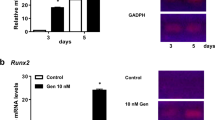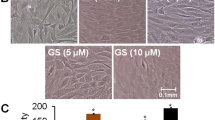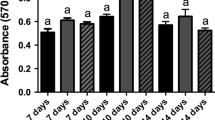Abstract
Purpose
To gain new insight into the roles of cruciferous vegetable-derived bioactive phytochemicals in bone cells, we investigated the effects of indole-3-carbinol (I3C) on cell proliferation and differentiation in estradiol (E2)-exposed calvarial osteoblasts that were obtained from neonatal rats.
Methods
Osteoblast activity was assessed by analyzing cellular DNA, cell-associated osteocalcin (OC) levels and alkaline phosphatase (AP) activity. We also examined [3H]-estrone (E1) metabolism and estrogen-agonistic and estrogen-antagonistic activities of 2-hydroxy (OH) E1 and 2-OHE2 and their capacity to displace [3H]-E2 at ER binding sites using competition studies.
Results
I3C did not affect on cellular DNA, OC levels or AP activity. However, I3C completely inhibited E2-induced increases in cell proliferation and differentiation in neonatal rat osteoblasts. Metabolic studies demonstrated that I3C promoted the conversion of [3H]-E1 to 2-OHE1 and 2-OHE2 and those higher rates of conversion (twofold–threefold) were archived when a higher dose of I3C was applied. Proliferation and differentiation studies showed that 2-OHE2 but not 2-OHE1 inhibited E2-induced increases in cell proliferation and differentiation via an ER-mediated mechanism. Likewise, Esr1 was expressed at high level than Esr2. 2-OHE1 showed no activity or affinity for ER.
Conclusions
This study is the first to show that a bioactive compound derived from cruciferous vegetables, I3C, abolishes the E2-mediated stimulation of cell activities including, proliferation and differentiation, in rat osteoblasts and increases the 2-hydroxylation of E1, resulting in the formation of inactive and anti-estrogenic metabolites. These results suggest that in neonatal rat osteoblasts, the anti-estrogenic effect of I3C is mediated by 2-OHE2 through ER-α.








Similar content being viewed by others
References
Lampe JW, Peterson S (2002) Brassica, biotransformation and cancer risk: genetic polymorphisms alter the preventive effects of cruciferous vegetables. J Nutr 132:2991–2994
Shertzer HG, Senft AP (2000) The micronutrient indole-3-carbinol: implications for disease and chemoprevention. Drug Metabol Drug Interact 17:159–188
Bradlow HL, Michnovicz JJ, Telang NT, Osborne MP (1991) Effects of dietary indole-3-carbinol on estradiol metabolism and spontaneous mammary tumors in mice. Carcinogenesis 12:1571–1574
Kojima T, Tanaka T, Mori H (1994) Chemoprevention of spontaneous endometrial cancer in female Donryu rats by dietary indole-3-carbinol. Cancer Res 54:1446–1449
Zhang Y, Talalay P, Cho C-G, Posner GH (1992) A mayor inducer of anticarcinogenic protective enzymes from broccoli: isolation and elucidation of structure. Proc Natl Acad Sci 89:2399–2403
Fahey JW, Zhang Y, Talalay P (1997) Broccoli sprouts: an exceptionally rich source of inducers of enzymes that protect against chemical carcinogens. Proc Natl Acad Sci 94:10367–10372
Michnovicz JJ, Bradlow HL (1990) Induction of estradiol metabolism by dietary indole-3-carbinol in humans. J Natl Cancer Inst 82:947–949
Chen I, Safe S, Bjeldanes L (1996) Indole-3-carbinol and diindolylmethane as aryl hydrocarbon (Ah) receptor agonists and antagonists in T47D human breast cancer cells. Biochem Pharmacol 51:1069–1076
Tsuchiya Y, Nakajima M, Yokoi T (2005) Cytochrome P450-mediated metabolism of estrogens and its regulation in human. Cancer Lett 227:115–124
Davies IJ, Naftolin F, Ryan KJ, Fishman J, Siu J (1975) The affinity of catechol estrogens for estrogen receptors in the pituitary and anterior hypothalamus of the rat. Endocrinology 97:554–557
Schneider J, Huh MM, Bradlow HL, Fishman J (1984) Antiestrogen action of 2-hydroxyestrone on MCF-7 human breast cancer cells. J Biol Chem 259:4840–4845
Gupta M, McDougal A, Safe S (1998) Estrogenic and antiestrogenic activities of 16alpha- and 2-hydroxy metabolites of 17beta-estradiol in MCF-7 and T47D human breast cancer cells. J Steroid Biochem Mol Biol 67:413–419
Newfield L, Goldsmith A, Bradlow HL, Auborn K (1993) Estrogen metabolism and human papillomavirus-induced tumors of the larynx: chemo-prophylaxis with indole-3-carbinol. Anticancer Res 13:337–341
Yuan F, Chen DZ, Liu K, Sepkovic DW, Bradlow HL, Auborn K (1999) Anti-estrogenic activities of indole-3-carbinol in cervical cells: implication for prevention of cervical cancer. Anticancer Res 19:1673–1680
Bradlow HL, Telang NT, Sepkovic DW, Osborne MP (1996) 2-Hydroxyestrone: the ‘good’ estrogen. J Endocrinol 150:S259–S265
Sepkovic DW, Bradlow HL (2009) Estrogen hydroxylation-the good and the bad steroid enzymes and cancer. Ann NY Acad Sci 1155:57–67
Lim SK, Won YL, Lee JH, Kwon SH, Lee EJ, Kim KR, Lee HC, Huh KB, Chung BC (1997) Altered hydroxylation of estrogen in patients with postmenopausal osteopenia. J Clin Endocrinol Metab 82:1001–1006
Leelawattana R, Ziambaras K, Roodman-Weiss J, Lyss C, Wagner D, Klug T, Armamento-Villareal R, Civitelli R (2000) The oxidative metabolism of estradiol conditions postmenopausal bone density and bone loss. J Bone Miner Res 15:2513–2520
Napoli N, Donepudi S, Sheikh S, Rini GB, Armamento-Villareal R (2005) Increased 2-hydroxylation of estrogen in women with a family history of osteoporosis. J Clin Endocrinol Metab 90:2035–2041
Enríquez J, Lemus AE, Chimal-Monroy J, Arzate H, García GA, Herrero B, Larrea F, Pérez-Palacios G (2007) The effects of synthetic 19-norprogestins on osteoblastic cell function are mediated by their non-phenolic reduced metabolites. J Endocrinol 193:493–504
Kaplow LS (1955) A histochemical procedure for localizing and evaluating leukocyte alkaline phosphatase activity in smears of blood and marrow. Blood 10:1023–1027
Arzate H, Alvárez-Pérez MA, Aguilar-Mendoza ME, Alvárez-Fregoso O (1998) Human cementum tumor cells have different features from human osteoblastic cells in vitro. J Periodontal Res 33:249–258
Labarca C, Paigen K (1980) A simple, rapid, and sensitive DNA assay procedure. Anal Biochem 102:344–352
Majeska RJ, Ryaby JT, Einhorn TA (1994) Direct modulation of osteoblastic activity with estrogen. J Bone Jt Surg Am 76:713–721
Qu Q, Perälä-Heape M, Kapanen A, Dahllund J, Salo J, Väänänen HK, Härkönen P (1998) Estrogen enhances differentiation of osteoblasts in mouse bone marrow culture. Bone 22:201–209
Bradford MM (1976) A rapid and sensitive method for the quantitation of microgram quantities of protein utilizing the principle of protein-dye binding. Ana Biochem 72:248–254
Nibbering PH, Van de Gevel JS, Van Furth R (1990) A cell-ELISA for the quantification of adherent murine macrophages and the surface expression of antigens. J Immunol Methods 131:25–32
Kisselev P, Schunck WH, Roots I, Schwarz D (2005) Association of CYP1A1 polymorphisms with differential metabolic activation of 17beta-estradiol and estrone. Cancer Res 65:2972–2978
Janssen JMMF, Bland R, Hewison M, Coughtrie MWH, Sharp S, Arts J, Pols HAP, van Leeuwen JPTM (1999) Estradiol formation by human osteoblasts via multiple pathways: relation with osteoblast function. J Cell Biochem 75:528–537
Pérez-Palacios G, Santillán R, García-Becerra R, Borja-Cacho E, Larrea F, Damían-Matsumura P, González L, Lemus AE (2006) Enhanced formation of non-phenolic androgen metabolites with intrinsic oestrogen-like gene transactivation potency in human breast cancer cells: a distinctive metabolic pattern. J Endocrinol 190:805–818
Lemus AE, Enríquez J, Hernández A, Santillán R, Pérez-Palacios G (2009) Bioconversion of norethisterone, a progesterone receptor agonist into estrogen receptor agonists in osteoblastic cells. J Endocrinol 200:199–206
Cheng Y-C, Prusoff WH (1973) Relationship between the inhibition constant (K i ) and the concentration of inhibitor which causes 50 per cent inhibition (I50) of an enzymatic reaction. Biochem Pharmacol 22:3099–3108
Reel JR, Humphrey RR, Shih Y-H, Windsor BL, Sakowski R, Creger PL, Edgren RA (1979) Competitive progesterone antagonists: receptor binding and biologic activity of testosterone and 19-nortestosterone derivatives. Fertil Steril 31:552–561
Westerlind KC, Gibson KJ, Malone P, Evans GL, Turner RT (1998) Differential effects of estrogen metabolites on bone and reproductive tissues of ovariectomized rats. J Bone Miner Res 13:1023–1031
Lotinun S, Westerlind KC, Turner RT (2001) Tissue-selective effects of continuous release of 2-hydroxy and 16α-hydroxyestrone on bone, uterus, and mammary gland in ovariectomized growing rats. J Endocrinol 170:165–174
Robinson JA, Waters KM, Turner RT, Spelsberg TC (2000) Direct action of naturally occurring estrogen metabolites on human osteoblastic cells. J Bone Miner Res 15:499–506
Napoli N, Armamento-Villareal R (2007) Estrogen hydroxylation in osteoporosis. Adv Clin Chem 43:211–227
Napoli N, Villareal DT, Mumm S, Halstead L, Sheikh S, Cagaanan M, Rini GB, Armamento-Villareal R (2005) Effect of CYP1A1 gene polymorphisms on estrogen metabolism and bone density. J Bone Miner Res 20:232–239
Acknowledgments
This study was fully supported by the Department of Reproductive Biology, INCMNSZ. The authors thank Dr. Verónica Navarro for technical assistance.
Author information
Authors and Affiliations
Corresponding author
Ethics declarations
Conflict of interest
All authors declare that there are no actual or potential conflicts of interest, including financial, personal or other relationships, with other people or organizations that could inappropriately influence this work.
Ethical approval
All procedures were performed in accordance with the institutional guidelines, and approved by the animal research ethical committee at INCMNSZ.
Informed consent
This article does not contain any studies with human participants performed by any of the authors.
Rights and permissions
About this article
Cite this article
Enríquez, J., Velázquez-Cruz, R., Parra‐Torres, A. et al. The anti-estrogenic activity of indole-3-carbinol in neonatal rat osteoblasts is associated with the estrogen receptor antagonist 2-hydroxyestradiol. J Endocrinol Invest 39, 1149–1158 (2016). https://doi.org/10.1007/s40618-016-0494-9
Received:
Accepted:
Published:
Issue Date:
DOI: https://doi.org/10.1007/s40618-016-0494-9




